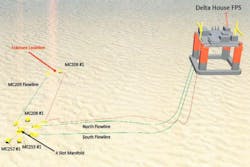BSEE issues panel investigation report on flowline jumper failure
Offshore staff
WASHINGTON, D.C. – The Bureau of Safety and Environmental Enforcement (BSEE) has released the panel investigation report on the October 2017 oil release located in about 4,463 ft (1,360 m) of water in the Gulf of Mexico approximately 40 mi (64 km) southeast of Venice, Louisiana.
The panel included BSEE career subject matter experts including petroleum engineers, pipeline engineers, and incident investigators.
Based on the panel’s findings and additional engagement with offshore operators, the report makes recommendations for improving subsea leak prevention and detection strategies.
The leak, reported by LLOG Exploration Offshore, LLC, resulted from fractured subsea infrastructure in Mississippi Canyon block 209 that tied into the company’s Delta House semisubmersible FPS at Mississippi Canyon block 254.
Over an approximate 24-hour period beginning the morning of Oct. 11, a fractured subsea wellhead jumper, that connected one wellhead to a pipeline end termination, released an estimated 16,000 bbl of oil into the Gulf.
Ocean currents flowed southwest at the time of the incident and there were no reports of oil reaching the coastline, BSEE said.
As a result of its investigation into the incident and its findings, BSEE recommends that operators increase scrutiny in the design, placement, and maintenance of their subsea infrastructure. In particular, the report recommends careful evaluation of flowline components and surveying methods to ensure suitability and longevity.
The panel also outlined several recommended improvements in subsea leak detection including enhanced monitoring technology and additional training.
The full report can be found here.
01/03/2020
